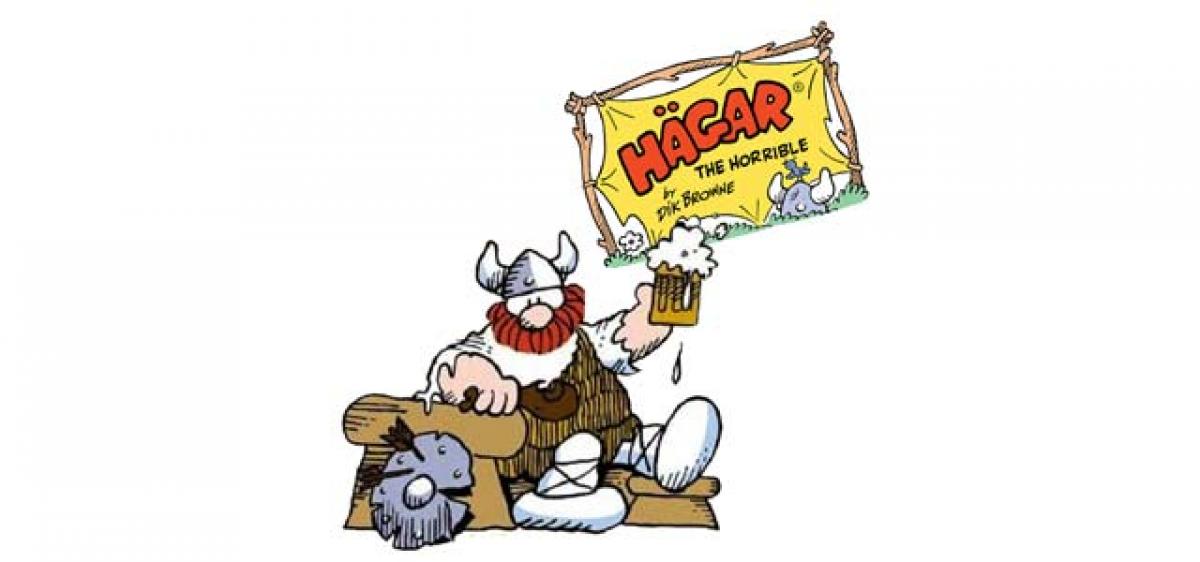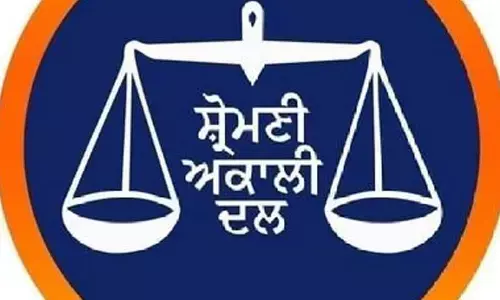Famous Viking and his entertaining exploits

The Vikings, who were distinguished by a startling adjective after their name, may have long lost their specific identity in the modern world, with the only of these epithets surviving (and flourishing) into our times being \"Bluetooth\". But not all of them have vanished, with one of their fierce warriors, and his unlikely family and associates, continuing to regale newspaper readers around the wor
Hagar the Horrible’, who made his debut in February, 1973, is still going strong and the comic strip surely tickles your funny bone with its satirical take on contemporary issues
The Vikings, who were distinguished by a startling adjective after their name, may have long lost their specific identity in the modern world, with the only of these epithets surviving (and flourishing) into our times being "Bluetooth". But not all of them have vanished, with one of their fierce warriors, and his unlikely family and associates, continuing to regale newspaper readers around the world for over four decades now.
American comics may be full of action, usually of the superhero variety, but humour has been a long-running and successful staple of their cousin – the newspaper comic strip – for over a century now, with 'Bringing Up Father' about accidental millionaire Jiggs and his ambitious wife Maggie starting in 1913 (and lasting till 2000), and many others spanning all genres and eras. One utilising the Dark Ages Scandinavia to great effect was Hagar the Horrible, who made his debut this month in 1973.
Like many others of his ilk, Hagar was not only a subtle depiction of contemporary (suburban) existence and its problems in a different setting, but also drew from his creator's life. Cartoonist Richard Arthur Allan 'Dik' Browne (August 11, 1917 - June 4, 1989) used the ‘Hagar the Terrible’ nickname his sons used for him, only changing it to the more alliterative, present name when he began drawing the cartoon character (which resembled him too).
Known earlier for co-creating ‘Hi and Lois’ with Mort ‘Beetle Bailey’ Walker, Browne used a clear, editorial-style line drawing, with minimal foreground or background detail, shading or embellishes for the strip – attributed to his experience as an illustrator in the courtroom, and subsequently during World War II in a US Army Engineer unit where he had to produce technical diagrams, maps and other documents.
A rather slovenly, unkempt, lazy, overweight, red-bearded Viking in an unnamed Norwegian coastal village, Hagar (pronounced "Hay-Gar") regularly raids England and sometimes France, but can be also glimpsed at home and his neighbourhood pub. While he may look likely a fierce barbarian, he has a soft side, is frequently clueless and naive, and in awe of his formidable wife, Helga, who often chides him on his unprepossessing habits.
Apart from Helga, whose appearance is inspired by that of a Wagnerian Valkyrie, Hagar's family comprises Honi, their beautiful, sweet but also frequently over-dramatic teenage daughter, clueless about "girlish" things and confused whether she should become a warrior or a housewife, and Hamlet, their intelligent, clean, obedient and studious young son, almost always seen reading a book and with no interest in becoming a Viking (he wants to be a dentist, much to be his father's mortification).
Then there is Hagar's dog, Snert, who wears a miniature Viking helmet like everyone else in the household, barks with a Viking accent ("voof") and understands everything his master tells him, but usually refuses to do what he's told, and the family's duck, Kvack, who is Helga's friend and confidante, and usually spies on Hagar.
Other key characters include Hagar's best friend and lieutenant in Viking raids, Lucky Eddie, who belies the popular depiction of brawny macho Viking warriors in being short, skinny, chinless, awkward and a weakling, Honi's inept minstrel boyfriend Lute, the young, tomboyish Hernia who is deeply (and one-sidedly) in love with Hamlet, cowled, druid-like "physician" Dr. Zook, the King's bureaucratic emissary, the Tax Collector, usually accompanied by the masked Executioner, Mr. Giggles, a torturer who torments captives by forcible tickling, various other raiders like Dirty Dirk and Mean Max, who are Hagar's friends/rivals and more.
The humour is often anachronistic with Hagar running into King Arthur, Robin Hood, Attila the Hun, Richard III, and Lady Godiva and even seer Nostradamus, or fantastic with encounters with dragons, trolls and even fairy tale characters like Puss in Boots. It makes use of stereotypes and ethic differences – in one strip, Hagar, after being blown off course and shipwrecked, thinks he has landed in England and sends Lucky Eddie ashore proclaiming he loves the English – but in turns out they have actually landed in Scotland.
And it ranges from witty – Hagar and his crew once meet a panicked Frenchman shouting "Les barbariens viennent!" (The barbarians are coming!) Turning and looking back, the bewildered Hagar says that he couldn't see any barbarians, or when Hamlet asks his mother how he came, or his sister, is told the stork brought them. Then he asks about his dad, and Helga says he was brought by four big storks – to sheer vaudeville, like the one in which Hagar carries away the entire contents of a smorgasbord.
Browne, who regularly provided a self-contained daily strip of two to four frames with a gag while the weekend installment was longer, retired in 1988 but the strip, continued by his son Chris Browne, is still going strong with Hagar's exploits, in English and translated in over a dozen languages, featuring in nearly 2,000 newspapers in 60 countries. Proof indeed that this Viking well tickles the funny bone!
















